Evaluation of Glass Coatings with Various Silica Content Corrosion in a 0.5 M HCl Water Solution
Abstract
1. Introduction
2. Materials and Methods
2.1. Sample Preparation
2.2. Corrosion Test
2.3. Characterization
2.4. Electrochemical Measurements
3. Results
3.1. Vacuum Firing
3.2. Macro Morphology and Corrosion Kinetics
3.3. Surface and Cross-Sectional Microstructures
3.4. Electrochemical Performance
3.4.1. Electrochemical Impedance Spectroscopy
3.4.2. Potentiodynamic Polarization Measurements
4. Discussion
5. Conclusions
Author Contributions
Funding
Institutional Review Board Statement
Informed Consent Statement
Data Availability Statement
Acknowledgments
Conflicts of Interest
References
- Sireli, G.K.; Bora, A.S.; Timur, S. Evaluating the mechanical behavior of electrochemically borided low-carbon steel. Surf. Coat. Technol. 2020, 381, 125177. [Google Scholar] [CrossRef]
- Chen, J.; Liu, Z.Y. The combination of strength and cryogenic impact toughness in low carbon 5Mn-5Ni steel. J. Alloy. Compd. 2020, 837, 155484. [Google Scholar] [CrossRef]
- Wang, H.L.; Fan, H.B.; Zheng, H.S. Corrosion inhibition of mild steel in hydrochloric acid solution by a mercapto-triazole compound. Mater. Chem. Phys. 2003, 77, 655–661. [Google Scholar] [CrossRef]
- Bentiss, F.; Lagrenee, M.; Traisnel, M.; Hornez, J.C. The corrosion inhibition of mild steel in acidic media by a new triazole derivative. Corros. Sci. 1999, 41, 789–803. [Google Scholar] [CrossRef]
- Mourya, P.; Banerjee, S.; Singh, M.M. Corrosion inhibition of mild steel in acidic solution by Tagetes erecta (Marigold flower) extract as a green inhibitor. Corros. Sci. 2014, 85, 352–363. [Google Scholar] [CrossRef]
- Ech-chihbi, E.; Nahlé, A.; Salim, R.; Benhiba, F.; Moussaif, A.; El-Hajjaji, F.; Oudda, H.; Guenbour, A.; Taleb, M.; Warad, I.; et al. Computational, MD simulation, SEM/EDX and experimental studies for understanding adsorption of benzimidazole derivatives as corrosion inhibitors in 1.0 M HCl solution. J. Alloy. Compd. 2020, 844, 155842. [Google Scholar] [CrossRef]
- Rbaa, M.; Dohare, P.; Berisha, A.; Dagdag, O.; Lakhrissi, L.; Galai, M.; Lakhrissi, B.; Touhami, M.E.; Warad, I.; Zarrouk, A. New Epoxy sugar based glucose derivatives as eco-friendly corrosion inhibitors for the carbon steel in 1.0 M HCl: Experimental and theoretical investigations. J. Alloy. Compd. 2020, 833, 154949. [Google Scholar] [CrossRef]
- Zhang, J.; Rahman, Z.U.; Zheng, Y.; Zhu, C.; Tian, M.; Wang, D. Nanoflower like SnO2-TiO2 nanotubes composite photoelectrode for efficient photocathodic protection of 304 stainless steel. Appl. Surf. Sci. 2018, 457, 516–521. [Google Scholar] [CrossRef]
- Branzoi, F.; Pahom, Z.; Nechifor, G. Corrosion protection of new composite polymer coating for carbon steel in sulfuric acid medium by electrochemical methods. J. Adhes. Sci. Technol. 2018, 32, 2364–2380. [Google Scholar] [CrossRef]
- Ashassi-Sorkhabi, H.; Kazempour, A. Influence of fluid flow on the performance of polyethylene glycol as a green corrosion inhibitor. J. Adhes. Sci. Technol. 2020, 34, 1653–1663. [Google Scholar] [CrossRef]
- Saeed, M.T. Corrosion inhibition of carbon steel in sulfuric acid by bicyclic isoxazolidines. Anti-Corros. Method. Mater. 2004, 51, 389–398. [Google Scholar] [CrossRef]
- Rahman, S.U.; Saeed, M.T.; Ali, S.A. Cyclic nitrones as novel organic corrosion inhibitors for carbon steel in acidic media. Anti-Corros. Method. Mater. 2005, 52, 154–159. [Google Scholar] [CrossRef]
- Berrissoul, A.; Ouarhach, A.; Benhiba, F.; Romane, A.; Zarrouk, A.; Guenbour, A.; Dikici, B.; Dafali, A. Evaluation of Lavandula mairei extract as green inhibitor for mild steel corrosion in 1 M HCl solution. Experimental and theoretical approach. J. Mol. Liq. 2020, 313, 113493. [Google Scholar] [CrossRef]
- Li, H.B.; Liang, K.M.; Mei, L.F.; Gu, S.R.; Wang, S.X. Oxidation protection of mild steel by zirconia sol-gel coatings. Mater. Lett. 2001, 51, 320–324. [Google Scholar] [CrossRef]
- Ates, S.; Baran Aydin, E.; Yazici, B. The corrosion behavior of the SnO2-coated mild steel in HCl solution at different temperature. J. Adhes. Sci. Technol. 2021, 35, 419–435. [Google Scholar] [CrossRef]
- Stambolova, I.; Yordanov, S.; Lakov, L.; Vassilev, S.; Blaskov, V.; Jivov, B. Preparation of sol-gel SiO2 coatings on steel and their corrosion resistance. In Proceedings of the 13th National Congress on Theoretical and Applied Mechanics, Sofia, Bulgaria, 6–10 September 2017; Vassilev, V.M., Nikolov, S.G., Datcheva, M.D., Ivanova, Y.P., Eds.; E D P Sciences: Jules, France, 2017; Volume 3, pp. 154–196. [Google Scholar]
- Yang, S.; Yang, L.; Chen, M.; Wang, J.; Zhu, S.; Wang, F. Understanding of failure mechanisms of the oxide scales formed on nanocrystalline coatings with different Al content during cyclic oxidation. Acta Mater. 2021, 205, 116576. [Google Scholar] [CrossRef]
- Liao, Y.; Zhang, B.; Chen, M.; Feng, M.; Wang, J.; Zhu, S.; Wang, F. Self-healing metal-enamel composite coating and its protection for TiAl alloy against oxidation under thermal shock in NaCl solution. Corros. Sci. 2020, 167, 108526. [Google Scholar] [CrossRef]
- Yu, Z.; Chen, M.; Chen, K.; Xie, D.; Zhu, S.; Wang, F. Corrosion of enamel with and without CaF2 in molten aluminum at 750 °C. Corros. Sci. 2019, 148, 228–236. [Google Scholar] [CrossRef]
- Chen, K.; Chen, M.; Yu, Z.; Wang, Q.; Li, X.; Zhu, S.; Wang, F. Corrosion of SiO2-B2O3-Al2O3-CaF2-R2O (R = Na and K) enamels with different content of ZrO2 in H2SO4 and NaOH solutions. Ceram. Int. 2019, 45, 14958–14967. [Google Scholar] [CrossRef]
- Wu, M.Y.; Chen, M.H.; Zhu, S.L.; Wang, F.H. Protection mechanism of enamel-alumina composite coatings on a Cr-rich nickel-based superalloy against high-temperature oxidation. Surf. Coat. Technol. 2016, 285, 57–67. [Google Scholar] [CrossRef]
- Goleus, V.I.; Nagornaya, T.I.; Rubanova, O.N.; Kozyreva, T.I.; Gurzhii, O.B. Chemical stability of titanium enamel coatings. Glass Ceram. 2012, 69, 274–275. [Google Scholar] [CrossRef]
- Rodtsevich, S.P.; Tavgen, V.V.; Minkevich, T.S. Effect of alkali metal oxides on the properties of titanium containing glass enamels. Glass Ceram. 2007, 64, 244–246. [Google Scholar] [CrossRef]
- Rodtsevich, S.P.; Eliseev, S.Y.; Tavgen, V.V. Low-melting chemically resistant enamel for steel kitchenware. Glass Ceram. 2003, 60, 23–25. [Google Scholar] [CrossRef]
- Svetlov, V.A. Increasing corrosion resistance of titanium enamel coatings by modifying the slip. Glass Ceram. 1989, 46, 293–295. [Google Scholar] [CrossRef]
- Gin, S.; Jollivet, P.; Fournier, M.; Angeli, F.; Frugier, P.; Charpentier, T. Origin and consequences of silicate glass passivation by surface layers. Nat. Commun. 2015, 6, 6360. [Google Scholar] [CrossRef]
- Cailleteau, C.; Angeli, F.; Devreux, F.; Gin, S.; Jestin, J.; Jollivet, P.; Spalla, O. Insight into silicate-glass corrosion mechanisms. Nat. Mater. 2008, 7, 978–983. [Google Scholar] [CrossRef]
- Hellmann, R.; Cotte, S.; Cadel, E.; Malladi, S.; Karlsson, L.S.; Lozano-Perez, S.; Cabie, M.; Seyeux, A. Nanometre-scale evidence for interfacial dissolution-reprecipitation control of silicate glass corrosion. Nat. Mater. 2015, 14, 307–311. [Google Scholar] [CrossRef] [PubMed]
- Chen, K.; Chen, M.; Wang, Q.; Zhu, S.; Wang, F. Micro-alloys precipitation in NiO- and CoO-bearing enamel coatings and their effect on adherence of enamel/steel. Int. J. Appl. Glass Sci. 2018, 9, 70–84. [Google Scholar] [CrossRef]
- Dohmen, L.; Lenting, C.; Fonseca, R.O.C.; Nagel, T.; Heuser, A.; Geisler, T.; Denkler, R. Pattern Formation in Silicate Glass Corrosion Zones. Int. J. Appl. Glass Sci. 2013, 4, 357–370. [Google Scholar] [CrossRef]
- Geisler, T.; Janssen, A.; Scheiter, D.; Stephan, T.; Berndt, J.; Putnis, A. Aqueous corrosion of borosilicate glass under acidic conditions: A new corrosion mechanism. J. Non-Cryst. Solids 2010, 356, 1458–1465. [Google Scholar] [CrossRef]
- Gin, S.; Ribet, I.; Couillard, M. Role and properties of the gel formed during nuclear glass alteration: Importance of gel formation conditions. J. Nucl. Mater. 2001, 298, 1–10. [Google Scholar] [CrossRef]
- Gin, S.; Guittonneau, C.; Godon, N.; Neff, D.; Rebiscoul, D.; Cabie, M.; Mostefaoui, S. Nuclear glass durability: New insight into alteration layer properties. J. Phys. Chem. C 2011, 115, 18696–18706. [Google Scholar] [CrossRef]
- Gin, S. Open scientific questions about nuclear glass corrosion. In Proceedings of the 2nd International Summer School on Nuclear Glass Wasteform: Structure, Properties and Long-Term Behavior, France, 23–27 September 2014; Angeli, F., Delaye, J.M., Schuller, S., Pinet, O., Rebiscoul, D., Gin, S., Peuget, S., Eds.; Elsevier Science: Amsterdam, The Netherlands, 2014; pp. 163–171. [Google Scholar]
- Baran, E.; Cakir, A.; Yazici, B. Inhibitory effect of Gentiana olivieri extracts on the corrosion of mild steel in 0.5 M HCl: Electrochemical and phytochemical evaluation. Arab. J. Chem. 2019, 12, 4303–4319. [Google Scholar] [CrossRef]
- Behpour, M.; Ghoreishi, S.M.; Khayatkashani, M.; Soltani, N. Green approach to corrosion inhibition of mild steel in two acidic solutions by the extract of Punica granatum peel and main constituents. Mater. Chem. Phys. 2012, 131, 621–633. [Google Scholar] [CrossRef]
- Tansug, G.; Tuken, T.; Giray, E.S.; Findikkiran, G.; Sigircik, G.; Demirkol, O.; Erbil, M. A new corrosion inhibitor for copper protection. Corros. Sci. 2014, 84, 21–29. [Google Scholar] [CrossRef]
- Hagihara, K.; Okubo, M.; Yamasaki, M.; Nakano, T. Crystal-orientation-dependent corrosion behaviour of single crystals of a pure Mg and Mg-Al and Mg-Cu solid solutions. Corros. Sci. 2016, 109, 68–85. [Google Scholar] [CrossRef]
- Jorcin, J.B.; Orazem, M.E.; Pebere, N.; Tribollet, B. CPE analysis by local electrochemical impedance spectroscopy. Electrochim. Acta 2006, 51, 1473–1479. [Google Scholar] [CrossRef]
- Khattabi, M.; Benhiba, F.; Tabti, S.; Djedouani, A.; El Assyry, A.; Touzani, R.; Warad, I.; Oudda, H.; Zarrouk, A. Performance and computational studies of two soluble pyran derivatives as corrosion inhibitors for mild steel in HCl. J. Mol. Struct. 2019, 1196, 231–244. [Google Scholar] [CrossRef]
- Avci, G. Corrosion inhibition of indole-3-acetic acid on mild steel in 0.5 M HCl. Colloids Surf. A 2008, 317, 730–736. [Google Scholar] [CrossRef]
- Brawer, S.A.; White, W.B. Raman spectroscopic investigation of the structure of silicate glasses (II). Soda-alkaline earth-alumina ternary and quaternary glasses. J. Non-Cryst. Solids 1977, 23, 261–278. [Google Scholar] [CrossRef]
- Tsuda, H.; Jongebloed, W.L.; Stokroos, I.; Arends, J. Combined Raman and SEM study on CaF2 formed on/in enamel by APF treatments. Caries Res. 1993, 27, 445–454. [Google Scholar] [CrossRef]
- Brawer, S.A.; White, W.B. Raman spectroscopic investigation of the structure of silicate glasses. I. The binary alkali silicates. J. Chem. Phys. 1975, 63, 2421–2432. [Google Scholar] [CrossRef]
- Sheth, N.; Ngo, D.; Banerjee, J.; Zhou, Y.; Pantano, C.G.; Kim, S.H. Probing hydrogen-bonding interactions of water molecules adsorbed on silica, sodium calcium silicate, and calcium aluminosilicate glasses. J. Phys. Chem. C 2018, 122, 17792–17801. [Google Scholar] [CrossRef]
- Sheth, N.; Luo, J.; Banerjee, J.; Pantano, C.G.; Kim, S.H. Characterization of surface structures of dealkalized soda lime silica glass using X-ray photoelectron, specular reflection infrared, attenuated total reflection infrared and sum frequency generation spectroscopies. J. Non-Cryst. Solids 2017, 474, 24–31. [Google Scholar] [CrossRef]
- Amma, S.-I.; Kim, S.H.; Pantano, C.G. Analysis of water and hydroxyl species in soda lime glass surfaces using attenuated total reflection (ATR)-IR spectroscopy. J. Am. Ceram. Soc. 2016, 99, 128–134. [Google Scholar] [CrossRef]
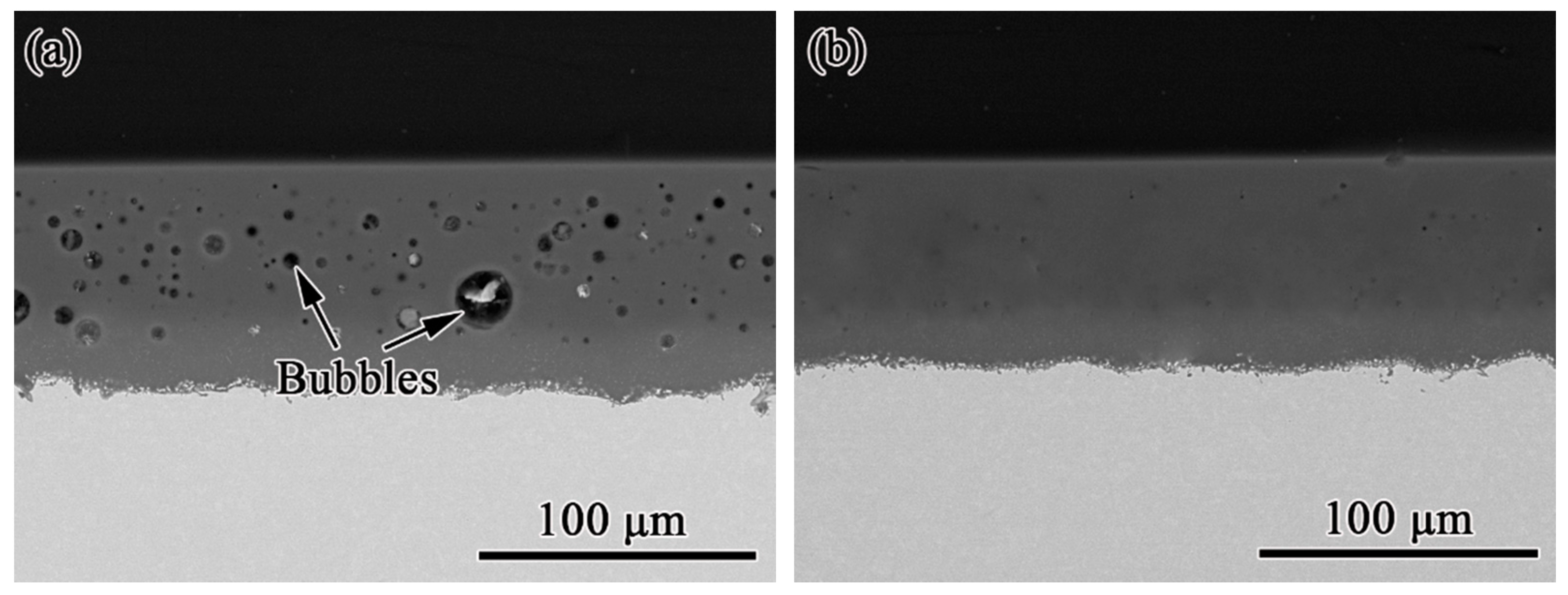
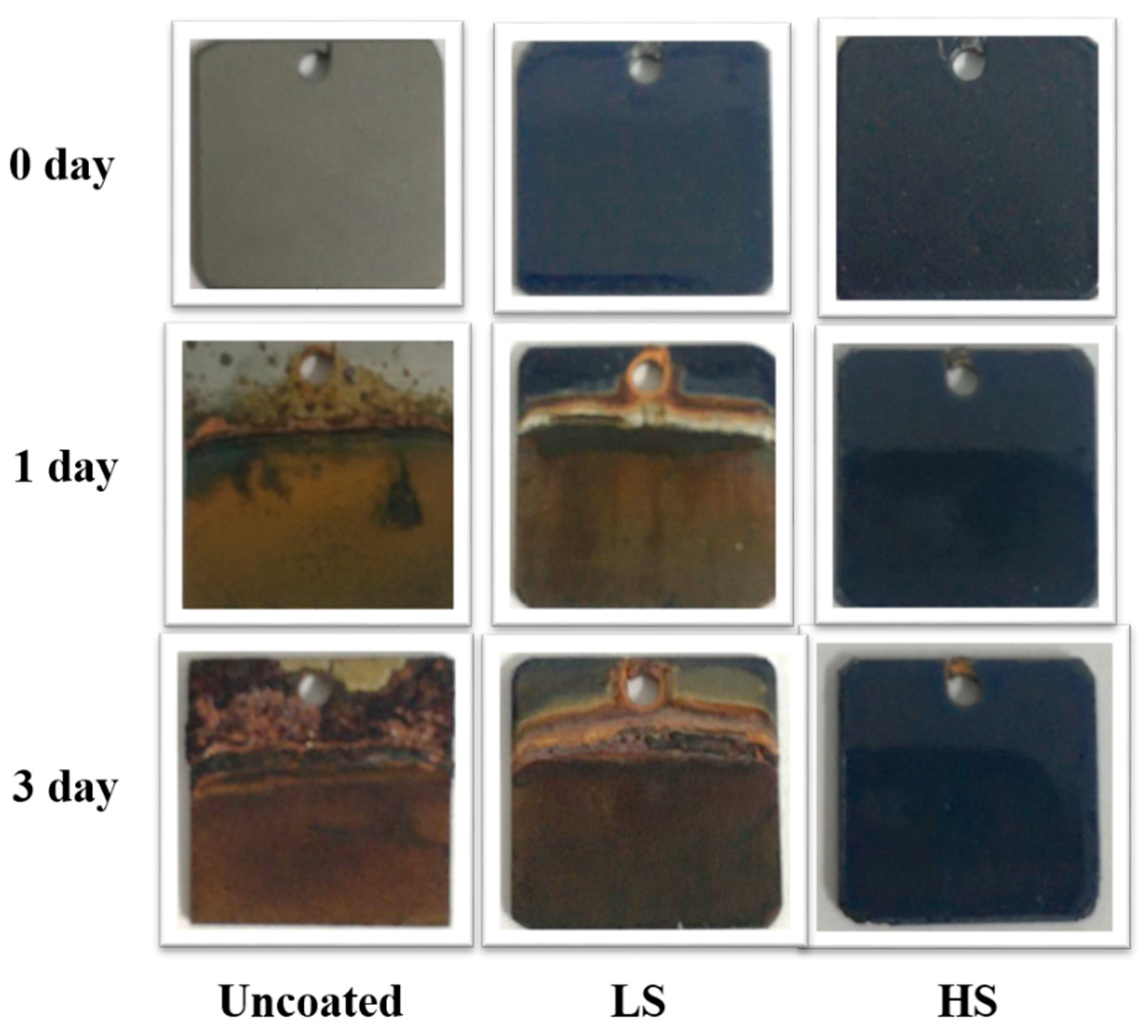
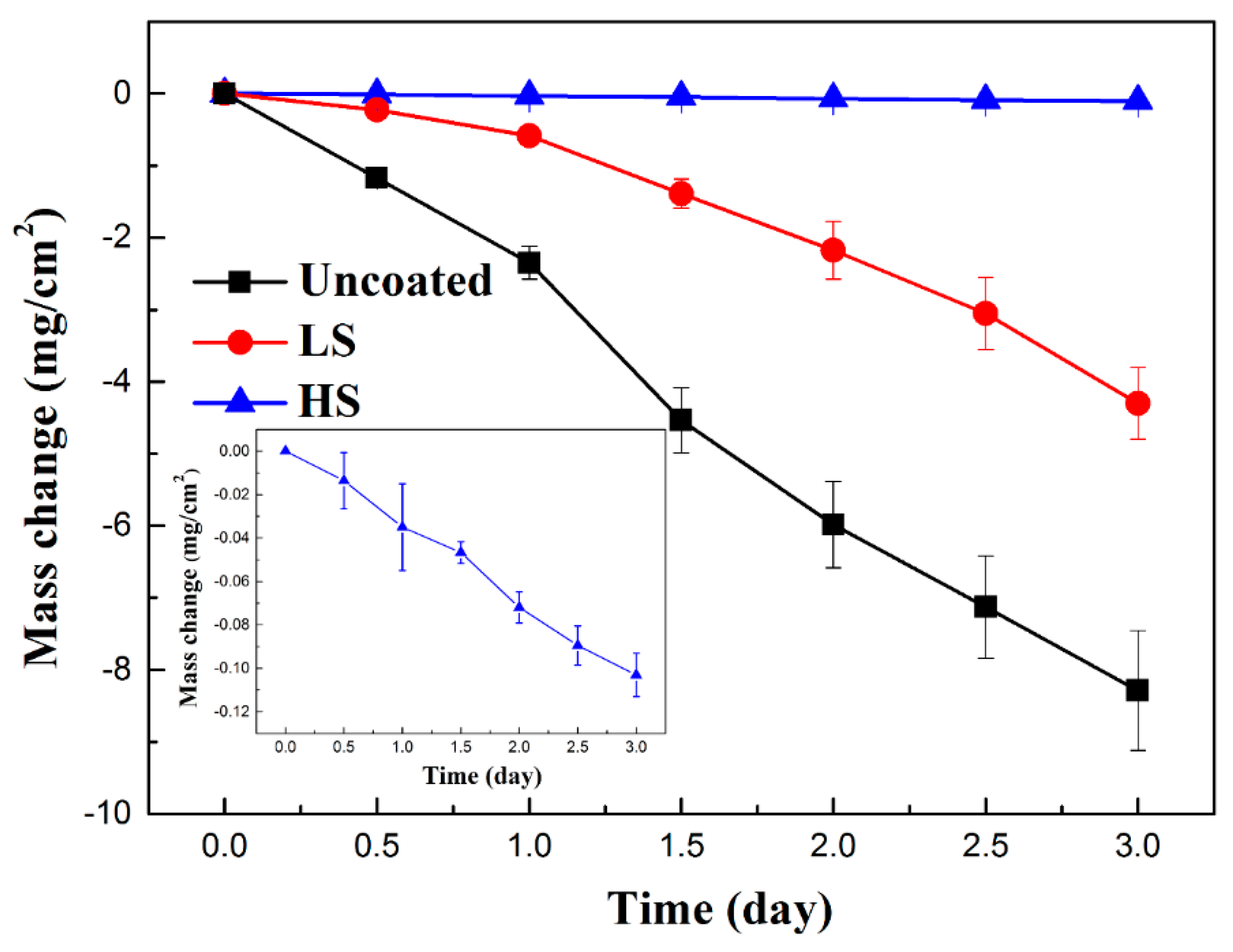
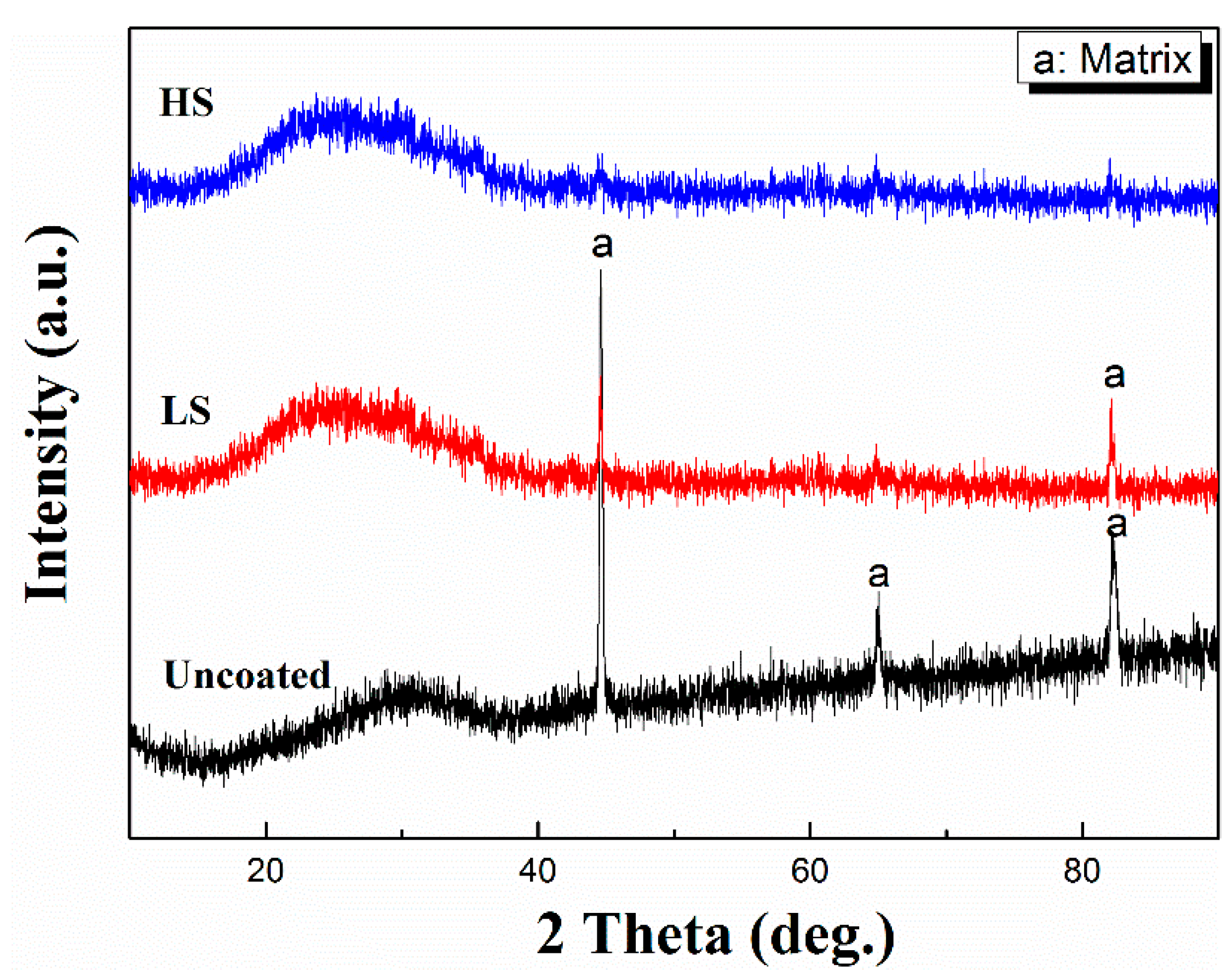

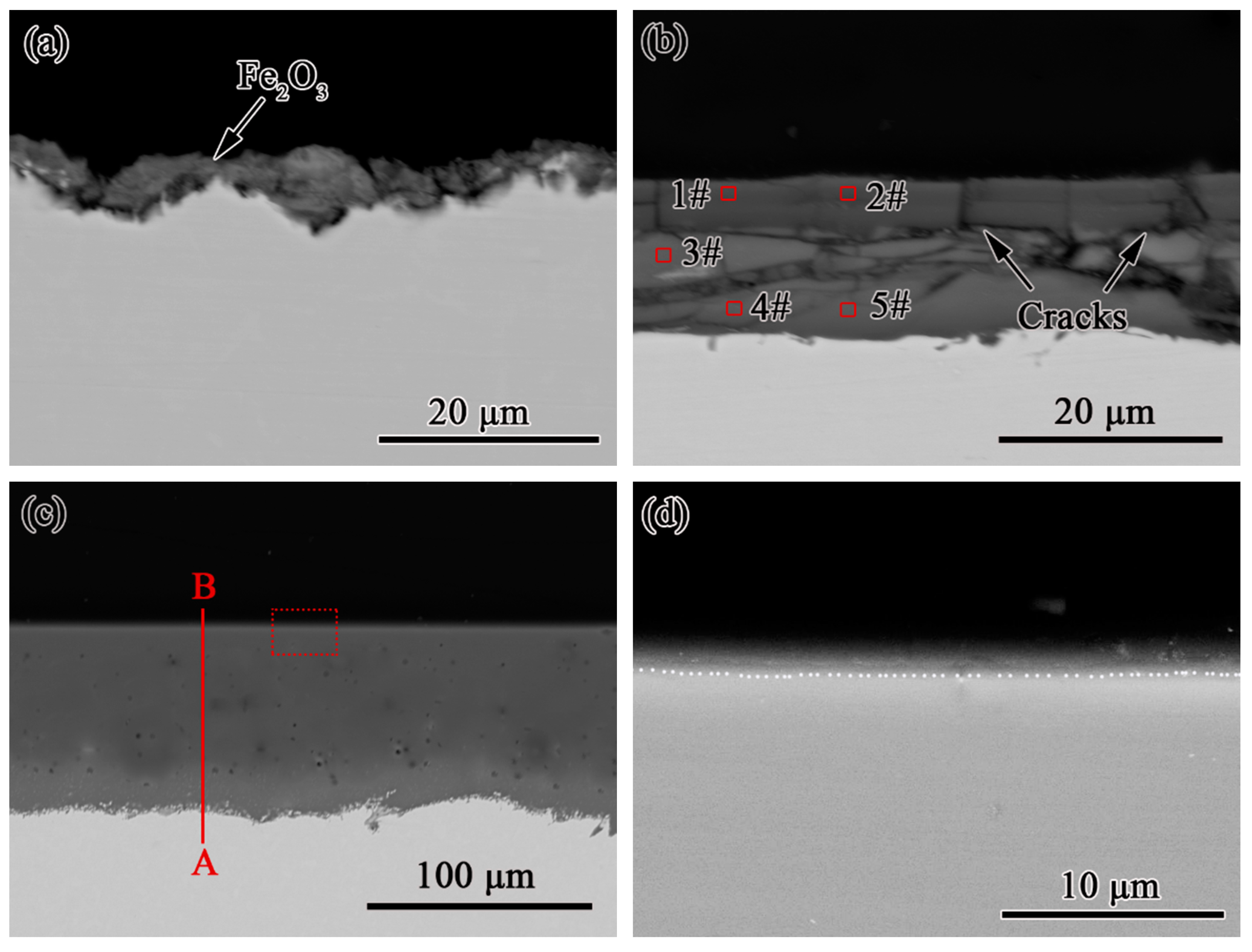
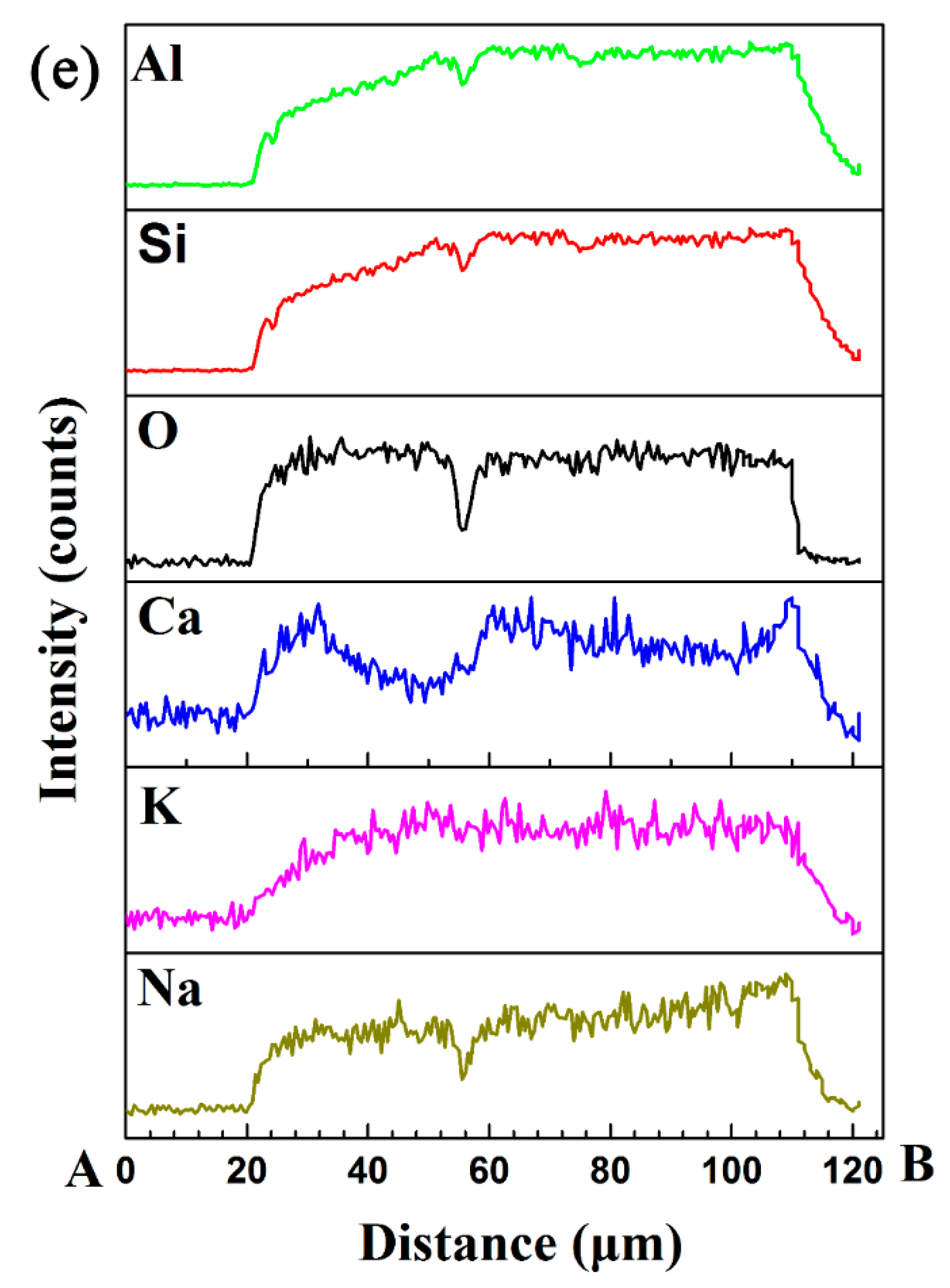
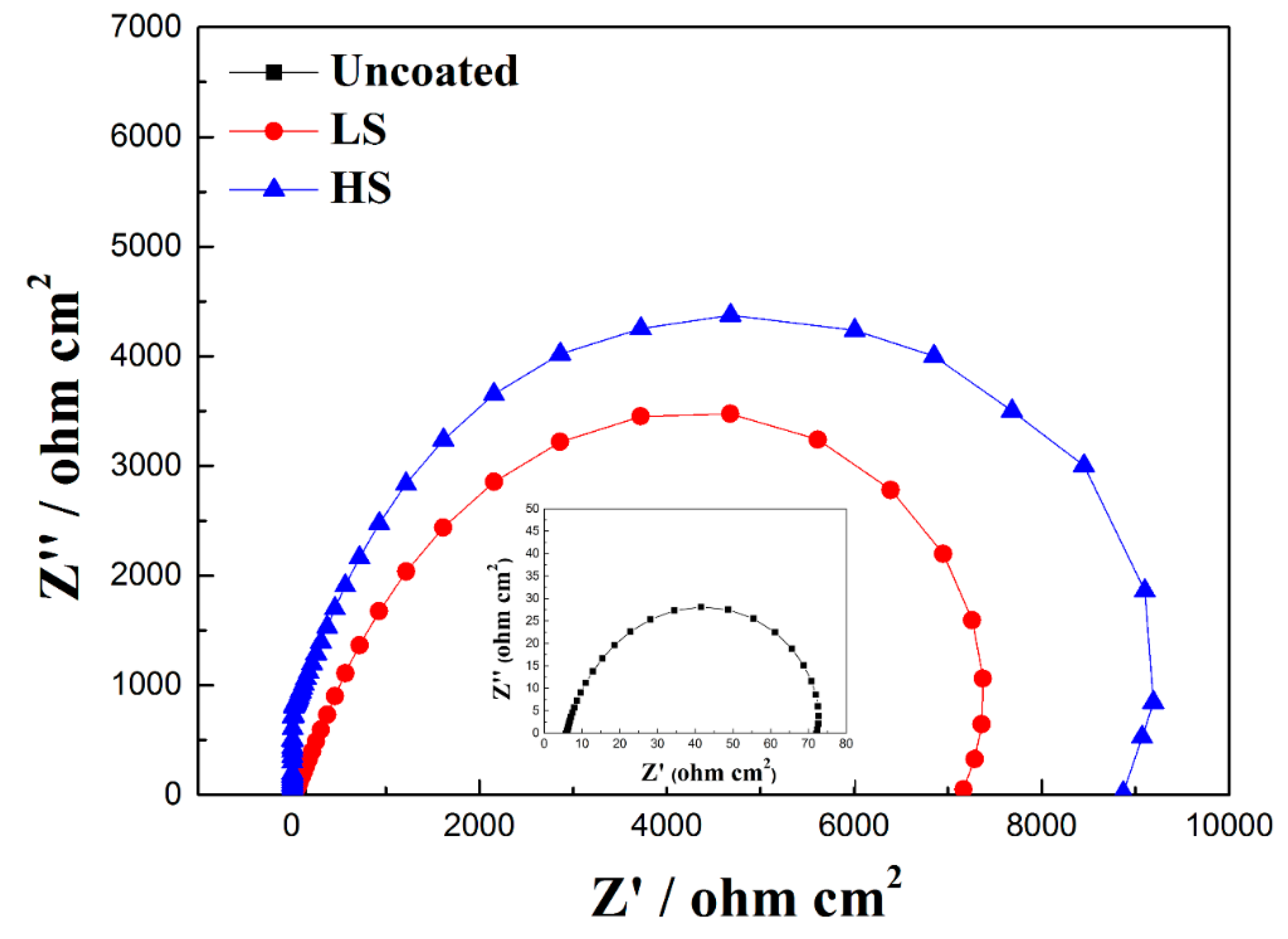

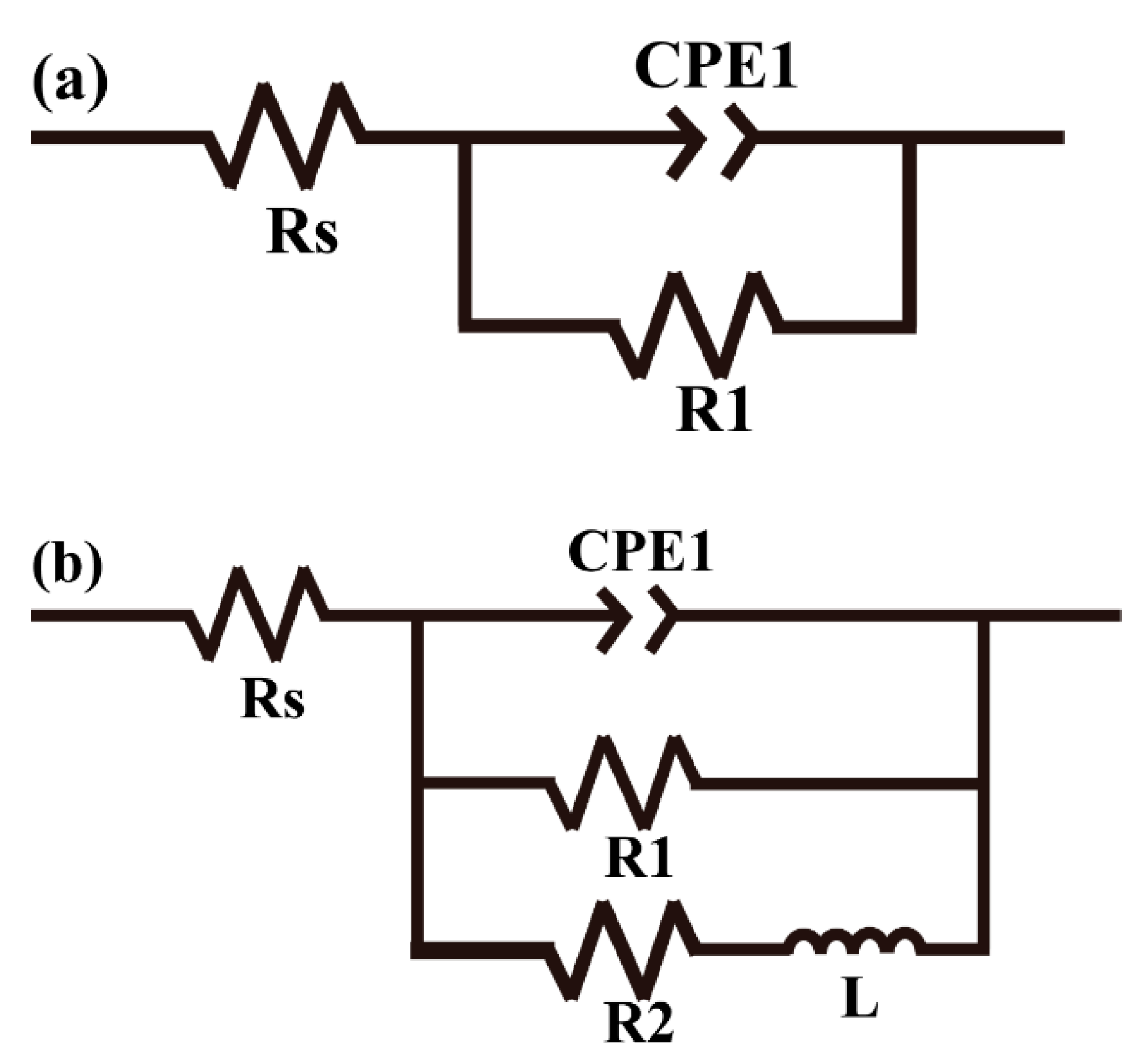
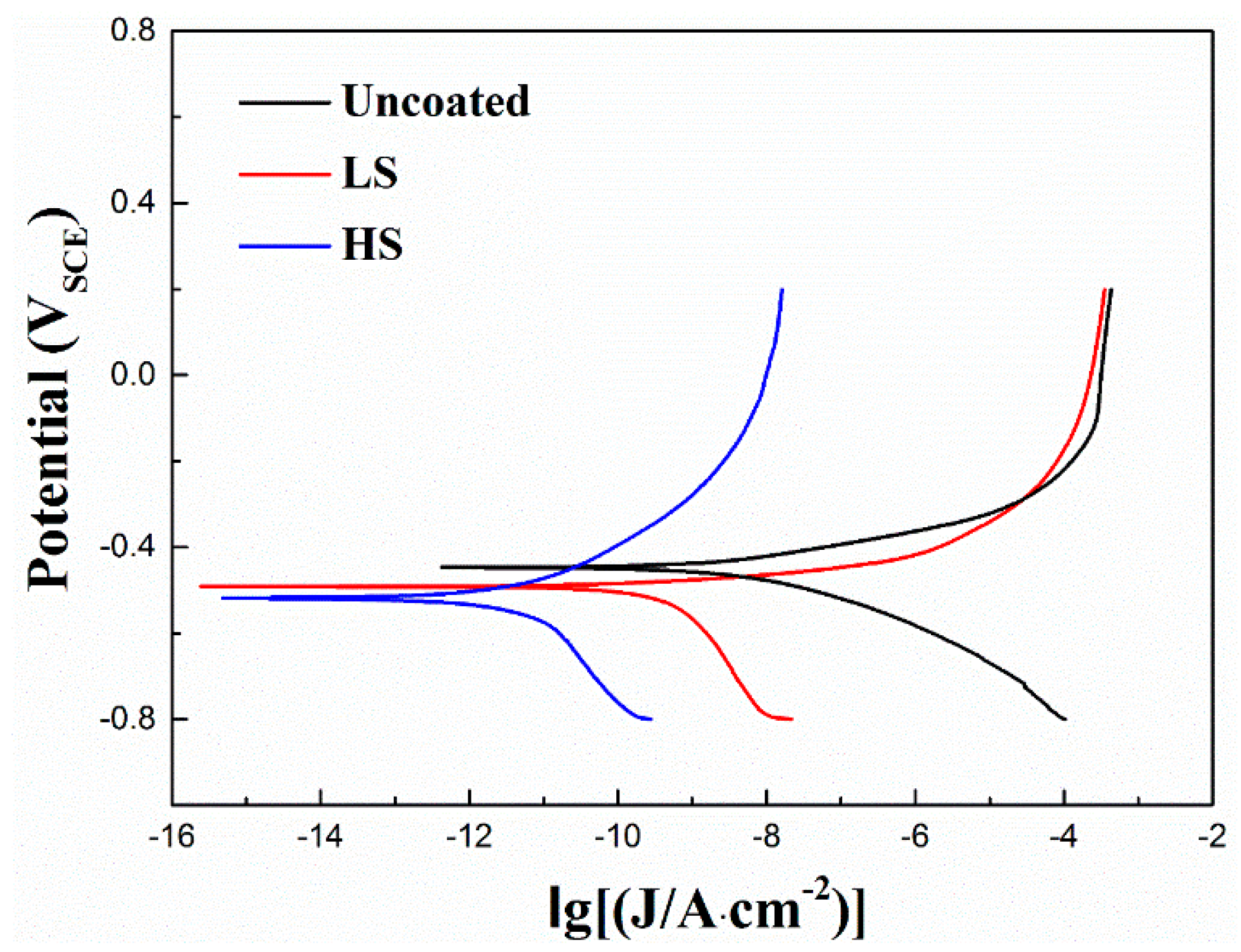

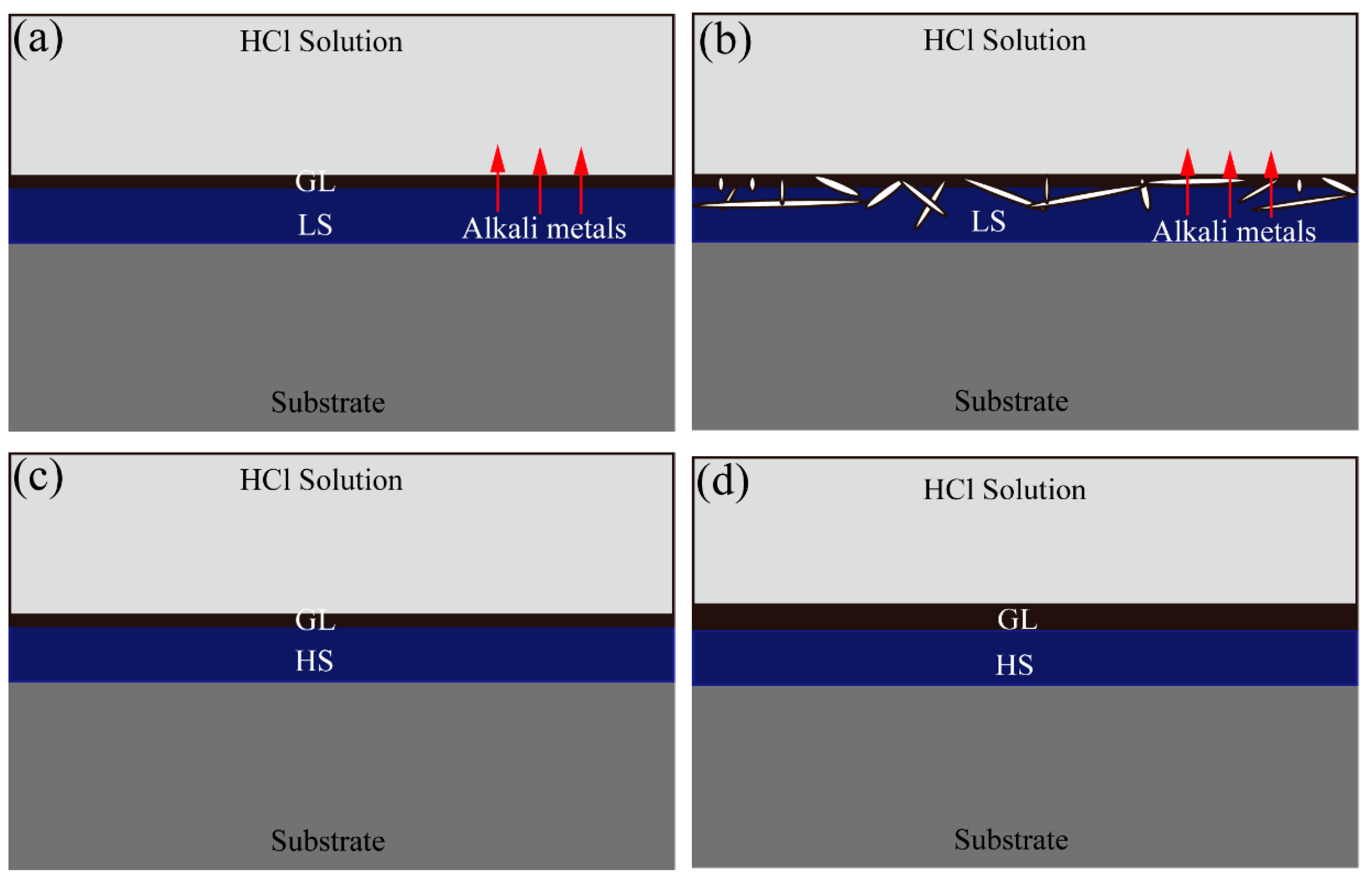
| SiO2 | B2O3 | Al2O3 | Na2O | K2O | CoO | CaF2 | |
|---|---|---|---|---|---|---|---|
| LS | 54.6 | 12.3 | 6.0 | 12.3 | 6.0 | 2.5 | 6.3 |
| HS | 64.6 | 9.6 | 4.7 | 9.6 | 4.6 | 1.9 | 5.0 |
| O | Na | Mg | Al | Si | K | Ca | Fe | Co | |
|---|---|---|---|---|---|---|---|---|---|
| Zone 1 | 73.1 | 0.4 | 1.2 | 3.9 | 16.1 | 0.6 | 2.4 | 1.7 | 0.6 |
| Zone 2 | 72.0 | 0.4 | 1.1 | 4.0 | 16.7 | 0.7 | 2.6 | 1.8 | 0.7 |
| Zone 3 | 62.1 | 7.5 | 5.7 | 2.4 | 11.2 | 2.5 | 7.4 | 0.4 | 0.8 |
| Zone 4 | 60.9 | 7.5 | 6.0 | 2.5 | 11.0 | 2.6 | 8.3 | 0.4 | 0.8 |
| Zone 5 | 60.8 | 7.4 | 6.0 | 2.4 | 11.2 | 2.6 | 8.3 | 0.4 | 0.9 |
| Rs (Ω) | R1 (Ω cm−2) | Y0-CPE1 (μS s−n cm−2) | R2 (Ω cm−2) | L (H cm−2) | Rp (Ω cm−2) | |
|---|---|---|---|---|---|---|
| Uncoated | 6 ± 1 | 66 ± 1 | 286 ± 5 | / | / | 66 ± 1 |
| LS | 24 ± 6 | 9304 ± 7 | 22 ± 9 | 1071 ± 14 | 2502 ± 14 | 960 ± 5 |
| HS | 328 ± 28 | (1583 ± 6) × 107 | 99 ± 24 | 1178 ± 23 | 3718 ± 34 | 1178 ± 23 |
| Sample | −Ecorr (mVSCE) | icor (mA cm−2) | βa (mV/dec) | −βc (mV/dec) | ηTafel |
|---|---|---|---|---|---|
| Uncoated | 447 | 0.122 | 13.98 | 8.53 | - |
| LS | 491 | 0.095 | 8.11 | 2.97 | 22.1 |
| HS | 517 | 0.007 | 5.78 | 2.94 | 94.3 |
Publisher’s Note: MDPI stays neutral with regard to jurisdictional claims in published maps and institutional affiliations. |
© 2021 by the authors. Licensee MDPI, Basel, Switzerland. This article is an open access article distributed under the terms and conditions of the Creative Commons Attribution (CC BY) license (http://creativecommons.org/licenses/by/4.0/).
Share and Cite
Wang, H.; Zhang, C.; Jiang, C.; Zhu, L.; Cui, J.; Han, L.; Chen, M.; Geng, S.; Wang, F. Evaluation of Glass Coatings with Various Silica Content Corrosion in a 0.5 M HCl Water Solution. Crystals 2021, 11, 346. https://doi.org/10.3390/cryst11040346
Wang H, Zhang C, Jiang C, Zhu L, Cui J, Han L, Chen M, Geng S, Wang F. Evaluation of Glass Coatings with Various Silica Content Corrosion in a 0.5 M HCl Water Solution. Crystals. 2021; 11(4):346. https://doi.org/10.3390/cryst11040346
Chicago/Turabian StyleWang, Hang, Chuan Zhang, Chengyang Jiang, Lijuan Zhu, Jiakai Cui, Lihong Han, Minghui Chen, Shujiang Geng, and Fuhui Wang. 2021. "Evaluation of Glass Coatings with Various Silica Content Corrosion in a 0.5 M HCl Water Solution" Crystals 11, no. 4: 346. https://doi.org/10.3390/cryst11040346
APA StyleWang, H., Zhang, C., Jiang, C., Zhu, L., Cui, J., Han, L., Chen, M., Geng, S., & Wang, F. (2021). Evaluation of Glass Coatings with Various Silica Content Corrosion in a 0.5 M HCl Water Solution. Crystals, 11(4), 346. https://doi.org/10.3390/cryst11040346






